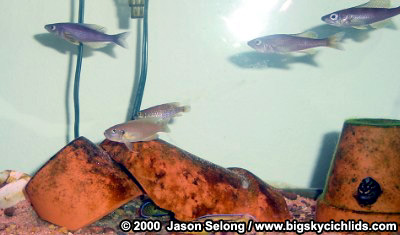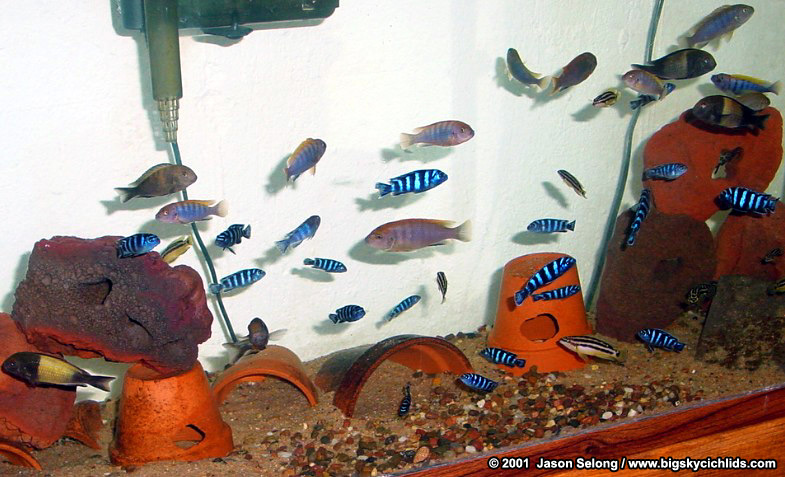|
The tank. Aquariums of any size can house cichlids. Smaller tanks (10-20 gallons) are appropriate for raising fry or maintaining and breeding smaller fish (e.g. "Lamprologus" stappersi , Julidochromis ornatus, etc...). Small aquariums limit the variety and number of fish that may be kept. A 29/30 aquarium gallon is the smallest practical size for a cichlid community. This size aquarium is suitable for many cichlid species and may support several different varieties. The standard 55 gallon aquarium is probably the best all-purpose aquarium size available for cichlids. Larger aquariums have greater stability in water quality and are able to support a larger total biomass by providing more space for cichlids which can be very territorial.
The Hardware. An aquarium must function as a self contained "ecosystem" and provide the inhabitants with space to live, metabolite free, oxygenated water, and food. A heater is essential since cichlids require water from 70-85 F. The optimal range for African cichlids is 76-78 F, while some South American cichlids require 80-84 F. A 250-300 watt heater is suitable for most cichlid aquariums of 29-70 gallons. Multiple heaters may be necessary for larger tanks or those located in colder rooms. Heating with multiple heaters also allow a backup in case of failure, though most homes are warm enough year round to sustain cichlids until a heater can be replaced. Filters are responsible for removing metabolites and suspended debris, and in some cases, oxygenating the water. Regardless of filter type, I recommend having two separate filters. The redundancy guarantees water will remain circulating in the case of a clog or failure. There are a variety of commercially available filters for every size aquarium. As a primary filter, I prefer using a power filter that hangs on the back of the tank for reliability and ease of cleaning. I use a powerhead with sponge attachment or an air pump and sponge filter as a backup filter. This combination of filtration provides both mechanical and biological filtration. Other types of filtration including canister, wet/dry, and fluid bed filters are also suitable for cichlids. Wet/dry and fluid bed filters are excellent biological filters. Care should be taken to frequently rinse filter cartridges or pre-filters to remove accumulated debris and ensure healthy growth of nitrifying bacteria. Substrate and decorative rock may also be added to cichlid tanks. While neither of these are required to maintain cichlids, they are usually essential for fish to display their best colors. There is an endless variety of aquarium gravels and sands available and all are suitable for cichlids. I prefer a thin layer of natural colored sand mixed with a small amount of coarse natural gravel. The layer of sand stops food from disappearing into the substrate as it would with all gravel, allowing the fish to consume it. The small amount of gravel is added for aesthetics. Sand should be used at a thickness that will not create pockets that allow anaerobic decay to occur. These are noticeable as black streaks in the substrate. Water flow through most coarse gravels does not allow this to occur even under several inches of gravel. Aquarium rock including the popular tufa, lava, and "holey" rock can be used in cichlid aquariums to allow hiding places and territories to guard. Tufa and lava rock are quite porous and will displace a minimal amount of water. These rocks are also easily drilled with a masonry bit to produce more hiding places. Clay flowerpots also have a natural look and make excellent hiding places. Plastic PVC may also be used to construct hiding places and spawning caves. Many species of cichlids are rock dwellers and will immediately take to rockwork. Lighting cichlid aquariums is a matter of personal preference. Cichlids do not require particularly strong lighting, but more light will be needed if plants are included in the aquarium. Water is the final essential ingredient for the cichlid aquarium. I use straight tap water and a commercial dechlorinator. This formula has been successful to maintain and breed the African cichlids I have kept. There is a boundless variety of chemicals to alter pH and mineral content and many hobbyist swear by these products. As with lighting, additives are also a matter of personal preference and trial and error. Routine Maintenance. The cichlid aquarium will require regular maintenance to ensure the enclosed "ecosystem" continues to function properly. Daily items should include checking the filtration apparatus to ensure optimal output, feeding, and observing tank inhabitants. Weekly or at least bi-weekly tasks should include a partial water change of 30-50%. Water changes will remove nitrate, the end product of nitrification. The breakdown of fed protein produces nitrogenous waste excreted by fish as ammonia, converted to less toxic nitrite, and then nitrate by aerobic bacteria in the biological filter. Water changes also often provide a stimulus to reproduction and can be a valuable tool if breeding cichlids is a goal. The fish. Choosing cichlids for the aquarium is a matter of the aquarium size, personal preference, and compatibility. Aquariums of 20-30 gallons are suitable for many of the Lake Tanganyika substrate spawners and shelldwellers including such genera as Neolamprologus, "Lamprologus", Julidochromis, Telmatochromis, and Chalinochromis. Lake Malawi peacocks (Aulonocara) will do well in at least a 30 gallon aquarium though males may grow to six inches. Lake Victoria haplochromines are also suitable for smaller aquariums. Malawi mbuna are probably best maintained in aquariums of 55 gallons or more, due to their territorial aggression, but sub-adult fish may be kept in smaller aquariums. The popular yellow Labidochromis caeruleus does fine in an 30 gallon aquarium due to its rather peaceful nature. Larger aquariums (55 gallons+) are suitable for housing most adults of Malawi mbuna such as Pseudotropheus, Labidochromis, Labeotropheus, and Melanochromis, and Malawi peacocks (Aulonocara spp.) and haplochromines (e.g. Protomelas). Tanganyika cichlids including Tropheus spp. will also benefit from larger quarters.
Cichlid choice is also a matter of personal preference. Cichlids from the different African lakes -as well as South American cichlids- may be mixed in aquariums. I find most similar sized cichlids, regardless of origin, generally do well together. The hobbyist wishing to simulate a natural situation would avoid mixing cichlids from different lakes and perhaps even those from different areas within a lake. Compatibility becomes and issue in any cichlid aquarium as territorial males may chase and injure tankmates. A cichlid compatibility chart may be found here for some suggestions. Overall compatibility, however, usually becomes a test of trial and error. I find raising fish groups of fry together allows for observation of overly aggressive fish which can be removed from the community. Attempting to introduce adult cichlids into aquariums with established residents may be quite difficult. A water change and rearrangement of hiding places will increase the chances for success. Confinement of particularly aggressive tankmates may also allow the new residents an opportunity to settle into the community. If propagation is the goal, an overly aggressive male may be segregated in a "breeder net" or with a tank divider while females are allowed to condition and then reintroduced for short periods to spawn. Other resources. Joining a local or national cichlid club will put you in contact with other cichlid hobbyists where you may obtain information on maintaining cichlids and specimens for your aquarium. Local cichlid clubs often sponsor auctions where fish may be obtained sometimes at very reasonable prices. Try www.fishlinkcentral.com to locate a local club. Reference material is also helpful for information on setup, maintenance, and identification of cichlids. Several reference sources are listed below.
References Buntbarsche Bulletin. (bi-monthly periodical). American Cichlid Association
Cichlid News. (quarterly periodical). Aquatic Promotions. Box 700166, Miami, FL 33170
Konings, A. 1998. Tanganyika cichlids in their natural habitat. Cichlid Press, 272pp.
Konings, A. 1995. Malawi cichlids in their natural habitat, 2nd edition. Cichlid Press, Germany, 352pp. Seehausen, O. 1996. Lake Victorian Rock Cichlids. Verduyn Cichlids, Germany.
|
|||
|
|||

